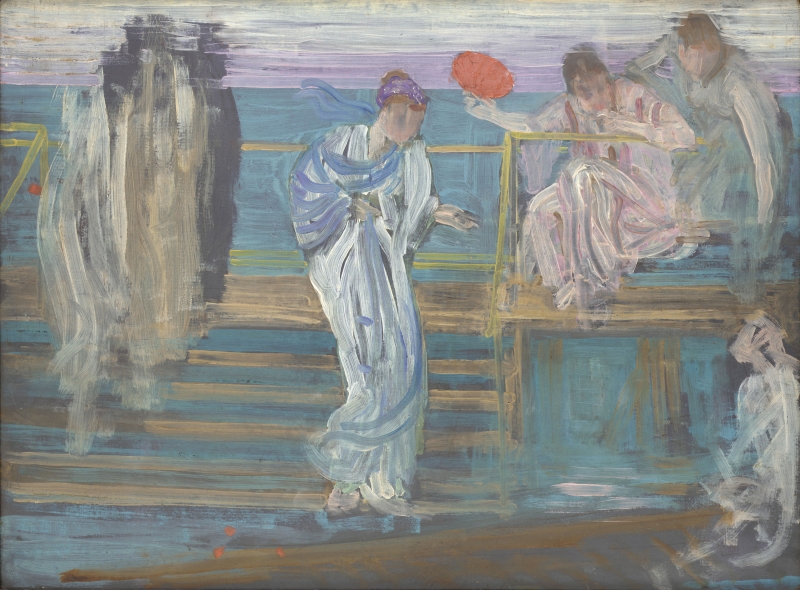Composition
Whistler made many drawings with variations on the poses of nude and robed figures for the series known as the 'Six Projects'. One, for instance, reproduced above, is on the verso of r.: Draped figures on a bridge; v.: Figures on a balcony [M.0314]; see also r.: Nude leaning back over balcony; v.: Figure composition [M.0450].

Kiyonaga, Ushiwaka serenading Jorurihime ..., triptych print, modern version, British Museum, 1949,0409,065.1-2
Beatrice and James Whistler owned the centre and right panels of a triptych, a woodcut by Torrii Kiyonaga (1752-1815), Joruri-Himie serenaded by Ushiwaha (reproduced above), which has some affinities of composition with Symphony in White and Red [YMSM 085], particularly in the relationship of the standing and seated figures on the balcony. It is not known if this woodcut or any other prints by Kiyonaga were in Whistler's collection at the time this picture was painted. This woodcut may have been acquired by Whistler after his bankruptcy in 1879, when all his earlier collections were sold; it was given to the British Museum by Rosalind Birnie Philip (1873-1958) in memory of her sister Beatrice Philip (Mrs E. W. Godwin, Mrs J. McN. Whistler) (1857-1896).
Technique
It is painted on a dark grey ground, and freely worked, with numerous pentimenti. The area of the two figures on the left remains barely defined. The blue sea was painted up to and around the figures. A fairly broad brush was used to apply the creamy textured paint, and shows clearly that many colours were mixed with complimentary colours, particularly in the pale pink robes of the woman with the red fan, where the pale white and pink brushstrokes are edged with brown, mauve, and fuchsia pink.
As Anna Greutzner Robins comments, 'The fluidity of the oil colour, dragged with a remarkable freedom of handling across the smooth support, and the reductive combinations of intense colour still amazes viewers.' 1
Conservation History
For some time Whistler had five of the 'Projects' hanging in his house in Cheyne Walk. In June 1892 they were cleaned and varnished by Stephen Richards (1844-1900), his picture restorer in London. Whistler then asked David Croal Thomson (1855-1930) to retrieve them from Richards and send them to him in Paris, 'I want my small pictures that you gave him to clean and varnish ... the sketches that used to hang in the dining room, Cheyne Walk ... Do kindly get them off to me at once - tomorrow?' 2
When they arrived he wrote to Richards from Paris:
'I have just received the five small paintings on millboard - (sketches of figures & sea) - that you have cleaned & varnished for me. They look pure and brilliant as on the day they were painted! -
But while you were about it, I wish enough you had seen to the condition of their backs - They were put down upon other cardboards some time ago, and they are all loose and bent about now … how is it that they come back to me without their frames? ... I was horrified! However happily they are unharmed.' 3
According to Freer Gallery conservation files the painting was cradled, cleaned and resurfaced in 1931, resurfaced in 1942, cleaned and surfaced in 1951.
Frame
For some time between 1890 and 1892 Whistler had the so-called 'Six Projects' (actually five!) hanging in his house in Cheyne Walk, although they were not exhibited. The five 'Projects' were certainly framed by 1892, when they were cleaned and varnished by Stephen Richards (1844-1900), but returned to the artist, as he complained 'without their frames.' 4
The current Grau-style frame dates from after it was bought by C. L. Freer in 1903. It is of similar construction to the frames on the other 'Projects'. 5 It was certainly on the frame by 1904, as seen in the photograph above.
Last updated: 23rd November 2020 by Margaret








